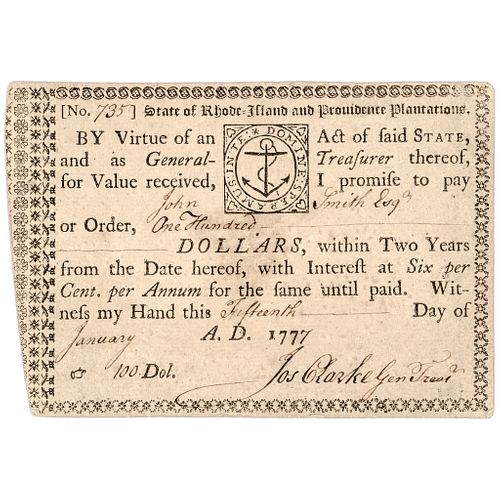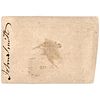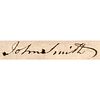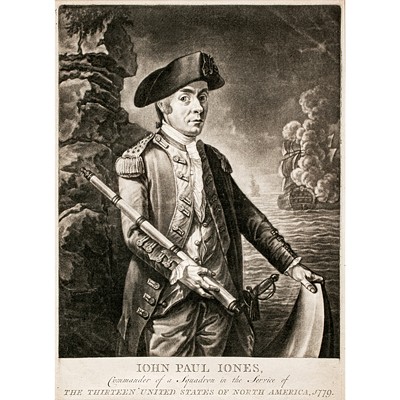1777 Rev. War Rhode Island Treasurers 2-Year 6% Debt Certificate, Anderson RI-1
Lot 73
Categories
Estimate:
$3,000 - $5,000
Absentee vs Live bid
Two ways to bid:
- Leave a max absentee bid and the platform will bid on your behalf up to your maximum bid during the live auction.
- Bid live during the auction and your bids will be submitted real-time to the auctioneer.
Bid Increments
| Price | Bid Increment |
|---|---|
| $0 | $10 |
| $200 | $20 |
| $300 | $25 |
| $500 | $50 |
| $1,000 | $100 |
| $2,000 | $200 |
| $3,000 | $250 |
| $5,000 | $500 |
| $10,000 | $1,000 |
| $20,000 | $2,000 |
| $30,000 | $2,500 |
| $50,000 | $5,000 |
| $100,000 | $10,000 |
| $200,000 | $20,000 |
| $300,000 | $25,000 |
| $500,000 | $50,000 |
About Auction
By Early American History Auctions
Jan 23, 2021
Set Reminder
2021-01-23 12:00:00
2021-01-23 12:00:00
America/New_York
Bidsquare
Bidsquare : Early American History Auction of Autographs, Americana, Political & Maps
https://www.bidsquare.com/auctions/early-american-history-auctions/early-american-history-auction-of-autographs-americana-political-maps-6311
311 Lots of Rare, Historic Autographs, Americana, Civil War Era, George Washington, Abraham Lincoln, Slavery & Black History, Revolutionary War Era, Colonial America, Federal Period, War of 1812, Colonial Currency, Indian Peace Medals & more... Early American History Auctions auctions@earlyamerican.com
311 Lots of Rare, Historic Autographs, Americana, Civil War Era, George Washington, Abraham Lincoln, Slavery & Black History, Revolutionary War Era, Colonial America, Federal Period, War of 1812, Colonial Currency, Indian Peace Medals & more... Early American History Auctions auctions@earlyamerican.com
- Lot Description
Rhode Island Currency
Rhode Island Revolutionary War State Debt Anderson RI-1 Treasurer's Two-Year 6% Interest Certificate, Fully Issued
January 15, 1777-Dated Revolutionary War Period, Rhode Island State Debt Treasurer's Two-Year 6% Interest Bearing Certificate, $100, Anderson RI-1, High Rarity-7, Fully Issued and Signed by Joseph Clarke as Treasurer, Choice Very Fine.
Anderson RI-1. Rated by Anderson as High Rarity-7 (Perhaps 4 to 6 Existent), yet it might be rarer than that rating as only three examples have been traced to our best knowledge. Listed on page 158 for this major type as illustrated in "The Price of Liberty - The Public Debt of the American Revolution" by William G. Anderson, 1983. Not Listed in either Eric Newman's, "The Early Paper Money of America" or the Friedberg Paper Money reference, yet somewhat similar in design to other Newman listed note series. An Exceedingly Rare and important "General Treasurer's" Printed Fiscal Document, (Handwritten Dates and Denominations) January 15, 1777, being the First Revolutionary War Rhode Island Debt Certificate. This Certificate bearing a printed Six Percent Interest per Annum, and a partial printed denomination in "DOLLARS", being fully issued and Signed, "Jos. Clarke Gen Treasr". This is the first issued funding use of debt by the State of Rhode Island after the signing of the Declaration of Independence and historic as such. Typeset and well printed on heavy laid period paper, which remains crisp and stiff with traces of original press text embossing seen on its blank reverse. There is a trace of prior mounting on the reverse center with just faint show-through to the face side, handling is present but there are no heavy folds and this note appears superior to the Newman VI example, PCGS graded VF-30. The manuscript handwritten portions are accomplished in rich brown ink, that are clear and fully readable. The blank reverse has been boldly endorsed by this Certificate's owner, "John Smith". We believe John Smith likely to be the noted Sgt. John Smith of the 1st Rhode Island Regiment of the Continental Army, who also kept a diary during the American Revolutionary War.
This current example is remarkable in that it is serial number 735 which is only eleven numbers from the plate example illustrated in Anderson, which is number 724 in the amount of $200, both Certificates having been issues to the same American Patriot, John Smith. A beautiful example with minor soiling only. A "Key" Fiscal and Rhode Island currency rarity that is certainly a specialist note, being is very first we have ever cataloged.
Sgt. John Smith of the 1st Rhode Island Regiment kept a diary during the American Revolution that explains why the Continental Army had a hard time recruiting soldiers.
After more than a month of marching, sometimes in the rain, sometimes ill and sometimes without finding food, the men were treated to court martials and severe punishments. Some of the troops refused to work because they hadn't received the clothing they'd been promised.
The 1st Rhode Island Regiment was organized by James Mitchell Varnum, who had served in the Kentish Guards with Nathanael Greene. Varnum was promoted to brigadier general in 1777, and the unit was eventually commanded by Col. Christopher Greene, a distant cousin of Nathanael Greene.
Sgt. John Smith of the 1st Rhode Island Regiment expected no mercy from the Hessian troops that would soon attack his garrison on the banks of the Delaware River.
It was Oct. 21, 1777, and Smith was holding Fort Mercer on Red Bank Plantation in New Jersey. The British had captured Philadelphia less than a month earlier. George Washington intended to starve the enemy out of the city. He ordered two forts built on either side of the river to block supply ships from reaching Philadelphia.
John Smith had enlisted for three years in the spring of 1777. His regiment consisted of Rhode Islanders from Kent and King counties and would later be noted for recruiting African-American soldiers. The 1st Rhode Island Regiment was part of Gen. Nathanael Greene's brigade.
Sgt. John Smith of the 1st Rhode Island Regiment expected no mercy from the Hessian troops that would soon attack his garrison on the banks of the Delaware River.
Springfield portable house.
It was Oct. 21, 1777, and Smith was holding Fort Mercer on Red Bank Plantation in New Jersey. The British had captured Philadelphia less than a month earlier. George Washington intended to starve the enemy out of the city. He ordered two forts built on either side of the river to block supply ships from reaching Philadelphia.
John Smith had enlisted for three years in the spring of 1777. His regiment consisted of Rhode Islanders from Kent and King counties and would later be noted for recruiting African-American soldiers. The 1st Rhode Island Regiment was part of Gen. Nathanael Greene's brigade.
The Continental Army, though outnumbered, would defeat the Hessian troops during the Battle of Red Bank on Oct. 22, 1777. The victory boosted the Americans' morale when their outlook for the war was bleak.
John Smith recorded the battle preparations in his diary:
we were Inform'd that a Party of Regulars had Landed at [blank] ferey to attacke our fort - we Remov'd all our tents & baggage into the Citidale & Every man was Employd at worke on the fort to fortify the same - between 3 & 4 o Clock 300 more troops Came here to Reinforce us - we Cut Down an orchard by the fort & hald trees Round the fort to Keep off the Enemy - we had no Disturbance from the Enemy this Day - this is tusday 21st of October - Mr. Henery holden [departed] for home by whome I sent a Letter to my wife
The next day the Hessians advanced to the woods next to the fort. Smith wrote the Hessian commander sent a flag and demanded surrender - or else they'd show no mercy and 'put all to death.'
An American captain answered. "We'd asked no mercy nor did we expect any."
"We was determined to fight or die in defence of the Garrison," wrote Smith.
The flag returned and the enemy attacked, beginning with a brisk fire. The Hessians advanced with knives spades, pickaxes and saws to cut through the trees surrounding the fort. The American troops responded with a smart fire from artillery and small arms for 47 minutes - 'as smart as Ever was Known,' wrote Smith.
The firing continued until dark, when the Hessians retreated.
The Hessians reported more than 300 killed and wounded with 60 missing or captured, while the Americans reported 14 killed and about 25 wounded. The Hessian commander, Col. Karl von Donop, was mortally wounded.
John Smith, along with everyone in the garrison, stayed up all night dressing the wounded.
Smith went on to survive the winter at Valley Forge.
___________
See: JOURNAL ARTICLE
Sergeant John Smith's Diary of 1776
From Louise Rau: The Mississippi Valley Historical Review
Vol. 20, No. 2 (Sep., 1933), pp. 247-270 (24 pages)
Published By: Oxford University Press:
https://doi.org/10.2307/1896993
https://www.jstor.org/stable/1896993
- Shipping Info
-
Early American provides in-house worldwide shipping. Please contact us directly if you have questions about your specific shipping requirements.
-
- Buyer's Premium



 EUR
EUR CAD
CAD AUD
AUD GBP
GBP MXN
MXN HKD
HKD CNY
CNY MYR
MYR SEK
SEK SGD
SGD CHF
CHF THB
THB













